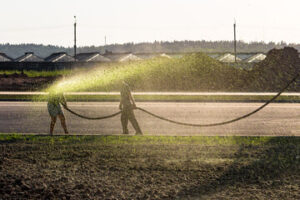Basically, hydroseeding is the process of sowing a lawn with a slurry of seeds and mulch. This is an alternative to broadcasting dry seeds. Hydroseeding is also used on construction sites as an erosion control technique.

This type of machine allowed for the spread of seeds and fertilizer over a large area, making the job easier and faster. Originally, the slurry consisted of water and seeds. The mixture was stored in large tanks, and the slurry was continually mixed through a mechanical paddle agitation process.
The hydroseeder was also able to spread seeds over steep slopes. This was not an easy task. These hillsides were impossible to seed with conventional methods.
The demand for a quick, easy, and effective solution was high. This was when HydroSeeder revolutionized the landscaping industry. The machine spread the seed over large areas and helped to promote grass growth. The hydroseeding machine also protected the grass seed from erosion.
As the demand for hydroseeding increased, more and more machines began to appear on the market. These machines were more affordable and user-friendly. They also came with a wider range of designs.
The first commercial hydroseeder was manufactured by Charles Finn. This machine sprayed seeds, water, and mulch over a large area. The mulch was then colored with a green dye to ensure that it was evenly spread.
Charles Finn also invented a straw, the mulching machine, which protected the seeds from erosion. These machines were also used in jet-agitated machines. These machines also used Reinco hydraulic agitated machines.
The first commercial hydroseeding machines were prohibitively expensive. However, the machines grew in popularity when people began to notice that they were able to grow grass faster. This allowed for larger, more successful projects.
Today, hydroseeding has evolved into an in-depth system using a wide range of additives. This includes tackifiers, moisture-retention polymers, and biostimulants. These additives ensure that the seeds will grow properly.
Hydroseeding also prevents erosion, which can be caused by rain or wind. This allows for better aesthetics and landscape features. The hydroseeding process can also lay a foundation for new wildlife habitats.
Depending on your region, the cost of hydroseeding can vary. Hydroseeding costs are affected by a variety of factors, including the size of your lawn, local water supply, slope, and weather. The cost of hydroseeding can range from $0 to $1000 per square foot, but there are also a few ways to lower costs.
Hydroseeding costs are also affected by the type of seed you choose. Some grasses thrive better in certain climates and will cost more. The type of fertilizer you use can also drive up costs.
Hydroseeding costs can also vary depending on whether you are using a professional or doing it yourself. A professional will charge a per-square-foot rate based on the size of your lawn. Smaller areas may be charged by the hour. A professional may also offer a discount for larger properties.
Hydroseeding is an effective way to add a new ground cover to bare or disturbed areas. It is also an effective means of erosion control. A hydroseeder is a machine that applies seed to the surface of the ground. This method is less labor-intensive than planting sod, and it can be used in areas where hand seeding is difficult.
Hydroseeding is also a good option for homeowners who want to save money on their lawns. The cost of hydroseeding is significantly lower than the cost of sodding. However, you will still need to invest in a slurry mixture. Using the right type of slurry can help the seed take root quickly.
The cost of hydroseeding is also affected by the type of soil you have. The slurry mixture you use will contain water and fertilizer. A high-quality slurry can cost up to $0.18 per square foot.
If you are going to rent a hydroseeder, it can cost up to $300 a day. This includes the cost of the machine and the cost of transporting it. Hydroseeding is not a quick process, and you may need to work for several hours. It is also best to prepare the ground before hydroseeding. This will help you ensure the process will be successful.
Choosing the best times of year to hydroseed a lawn is essential for optimal growth and aesthetics. There are two main reasons for growing new grass: spring and fall. Spring offers moderate temperatures and rain and is ideal for growing a new lawn. Fall is less humid and drier, allowing for faster grass growth.